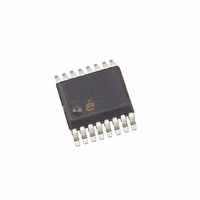ISL6742AAZA Intersil, ISL6742AAZA Datasheet - Page 11

ISL6742AAZA
Manufacturer Part Number
ISL6742AAZA
Description
IC CTRLR PWM DOUBLE ENDED 16QSOP
Manufacturer
Intersil
Datasheet
1.ISL6742AAZA.pdf
(18 pages)
Specifications of ISL6742AAZA
Pwm Type
Voltage/Current Mode
Number Of Outputs
4
Frequency - Max
2MHz
Duty Cycle
100%
Voltage - Supply
9 V ~ 16 V
Buck
No
Boost
No
Flyback
No
Inverting
No
Doubler
No
Divider
No
Cuk
No
Isolated
No
Operating Temperature
-40°C ~ 105°C
Package / Case
16-QSOP
Frequency-max
2MHz
Peak Reflow Compatible (260 C)
Yes
Rohs Compliant
Yes
Lead Free Status / RoHS Status
Lead free / RoHS Compliant
Available stocks
Company
Part Number
Manufacturer
Quantity
Price
Company:
Part Number:
ISL6742AAZA-T
Manufacturer:
Intersil
Quantity:
2 000
Part Number:
ISL6742AAZA-T
Manufacturer:
INTERSIL
Quantity:
20 000
The average current signal on IOUT remains accurate
provided that the output inductor current is continuous (CCM
operation). Once the inductor current becomes discontinuous
(DCM operation), IOUT represents 1/2 the peak inductor
current rather than the average current. This occurs because
the sample and hold circuitry is active only during the on-time
of the switching cycle. It is unable to detect when the inductor
current reaches zero during the off-time.
If average overcurrent limit is desired, IOUT may be used
with the available error amplifier of the ISL6742. Typically,
IOUT is divided down and filtered as required to achieve the
desired amplitude. The resulting signal is input to the current
error amplifier (IEA). The IEA is similar to the voltage EA
found in most PWM controllers, except it cannot source
current. Instead, VERR has a separate internal 1mA pull-up
current source.
Configure the IEA as an integrating (Type I) amplifier using
the internal 0.6V reference. The voltage applied at FB is
integrated against the 0.6V reference. The resulting signal,
VERR, is applied to the PWM comparator where it is
compared to the sawtooth voltage on RAMP. If FB is less
than 0.6V, the IEA will be open loop (can’t source current),
VERR will be at a level determined by the voltage loop, and
the duty cycle is unaffected. As the output load increases,
IOUT will increase, and the voltage applied to FB will
increase until it reaches 0.6V. At this point the IEA will
reduce VERR as required to maintain the output current at
the level that corresponds to the 0.6V reference. When the
output current again drops below the average current limit
threshold, the IEA returns to an open loop condition, and the
duty cycle is again controlled by the voltage loop.
The average current control loop behaves much the same
as the voltage control loop found in typical power supplies
except it regulates current rather than voltage.
The EA available on the ISL6742 may also be used as the
voltage EA for the voltage feedback control loop rather than
the current EA as described previously. An external op amp
may be used as either the current or voltage EA providing
the circuit is not allowed to source current into VERR. The
external EA must only sink current, which may be
accomplished by adding a diode in series with its output.
The 4x gain of the sample and hold buffer allows a range of
150mV to 1000mV peak on the CS signal, depending on the
resistor divider placed on IOUT. The overall bandwidth of the
average current loop is determined by the integrating current
EA compensation and the divider on IOUT.
11
ISL6742
The current EA crossover frequency, assuming R6 >>
(R4||R5), is expressed in Equation 7:
where f
with R4 may be used to provide a double-pole roll-off.
The average current loop bandwidth is normally set to be
much less than the switching frequency, typically less than
5kHz and often as slow as a few hundred hertz or less. This is
especially useful if the application experiences large surges.
The average current loop can be set to the steady state
overcurrent threshold and have a time response that is longer
than the required transient. The peak current limit can be set
higher than the expected transient so that it does not interfere
with the transient, but still protects for short-term larger faults.
In essence, a 2-stage overcurrent response is possible.
The peak overcurrent behavior is similar to most other PWM
controllers. If the peak current exceeds 1V, the active output
pulse is terminated immediately.
If voltage-mode control is used in a bridge topology, it should
be noted that peak current limit results in inherently unstable
operation. DC blocking capacitors used in voltage-mode
bridge topologies become unbalanced, as does the flux in
the transformer core. The average overcurrent circuitry
prevents this behavior by maintaining symmetric duty cycles
for each half-cycle. If the average current limit circuitry is not
used, a latching overcurrent shutdown method using
external components is recommended.
The CS to output propagation delay is increased by the
leading edge blanking (LEB) interval. The effective delay is
the sum of the two delays and is 130ns maximum.
Voltage Feed-Forward Operation
Voltage feed-forward is a technique used to regulate the
output voltage for changes in input voltage without the
f
CO
FIGURE 7. AVERAGE OVERCURRENT IMPLEMENTATION
=
---------------------------------- -
2π R6 C10
CO
⋅
150mV TO
is the crossover frequency. A capacitor in parallel
1000mV
1
⋅
C10
R6
Hz
R5
R4
1
2
3
4
5
6
7
8
VERR
FB
CS
IOUT
0.6V
ISL6742
S&H
4x
+
-
October 31, 2008
1
6
1
5
1
4
1
3
1
2
1
1
1
0
9
FN9183.2
(EQ. 7)










